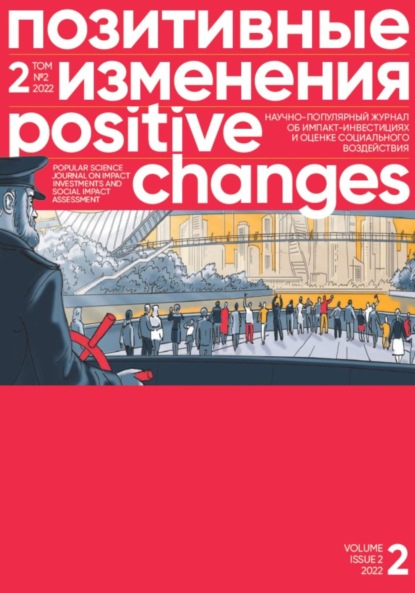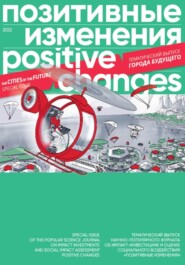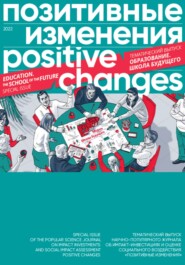По всем вопросам обращайтесь на: info@litportal.ru
(©) 2003-2024.
✖
Позитивные изменения. Том 2, № 2 (2022). Positive changes. Volume 2, Issue 2 (2022)
Настройки чтения
Размер шрифта
Высота строк
Поля
4. Amy Oliver. Regenerating Urban Neighborhoods: Through Synergies of Natural and Social Capital // An International Journal of Urban and ExtraUrban Studies. – 2013. – Volume 1.
5. C. Cellamare & F. Cognetti. Practices of Reappropriation. – Tracce Urbane, Planum Publisher, 2014.
6. Kevin S. Parikh. Digital Singularity: a Case for Humanity. – Avasant LLC, 2018.
7. Lisa Chemberlain. the Surprising Stickiness of the «15-Minute City» [Электронный ресурс] // Common Edge. 25.01.2022.
8. Robert E. Park and Ernest W. Burgess. the City. (Chicago, 1925).
9. Strong Towns [Электронный ресурс].
Old New Challenges for the Cities of the Future. Trends, Risks and Opportunities of Modern Urbanization
Digital citizens, artificial intelligence, local agendas, new-format developers investing in social and natural capital – all these are attributes of the cities of the future. Urbanist Peter Ivanov reasons why it is sometimes necessary to turn to the past in order to learn about the future and what changes await the urban environment.
Peter Ivanov
Urbanist, sociologist, partner in the Civil Engineering Laboratory (Krasnoyarsk), professor, Free University
NOT BY COVID ALONE
Until recently, everyone was talking about COVID-19 and how it would change cities. Public health was seemingly destined to become the key challenge for the cities of the future. The coronavirus pandemic revealed the critical vulnerability of our environment organization concepts. However, the response to that discovery had been prepared long ago and promoted by consultancy companies and urban activists (Chemberlain, 2022). Low-rise mixed-use development, extension of bicycle transportation infrastructure, and encouragement of pedestrian traffic. Perhaps only public transportation lost a few points in the face of the pandemic. Nevertheless, a revolution of thinking did not happen; the drama was coped with based on the already existing line of thought.
The new challenge for the cities of the future actually lies in the past. Something similar to what we are seeing in the cities of today has happened in the past. What I am talking about is community organizing.
The new challenge for the cities of the future actually lies in the past. Something similar to what we are seeing in the cities of today has happened in the past.
During the Chicago City Council elections in 1915 (Park, Burgess, 1925), citizens went to the polls and saw long lists of names that meant nothing to them. That crisis was met with a variety of mixed reactions. Chicagoans began organizing voter associations and local social movements, political parties began opening district offices and hiring district political bosses, and religious and philanthropic organizations launched the first round of community organizing. The city came to life and started building more complex social connections. In fact, the 1915 Chicago events were a logical response to the disorganization brought to the cities by rapid growth accompanying the industrialization process.
DIGITALIZATION VS RADICAL MUNICIPALISM
From the dialectical point of view, the cities of today are a battlefield of two trends. One is the trend toward digitalization and digitization (Lapina-Kratasyuk et al., 2021). Smart city systems use neural networks to solve all urban problems for the people. Digital citizens must rely on artificial intelligence, robots, and the good will of software developers. The creative energy freed from administration and routine work should be directed toward the production of even more advanced machines and even more appropriate accounting and control systems. Digital singularity, when technological development becomes ultimately unmanaged and inevitable (Parikh, 2018), is not that far off. Techno-optimists look boldly into the future and see the grandeur of new cities built with the rationality and orderliness of machines. In this reality, the urban planner appears as a programmer-technomage, confidently managing the endless data flows from various sensors, responding to any fluctuations in the urban environment. The city becomes intangible.
The other trend is radical municipalism. This direction puts the humans and human relationships at the core of the city infrastructure. A prime example is the Strong Towns movement in North America, whose members advocate for a radically new way of looking at how we build our cities. The Strong Towns movement seeks to make local government the highest point of collaboration for people working in one place. To this end, articles and podcasts, courses and short seminars are created for those who want to take action in their community. Supporters of the movement, who live in the same city, work together to make their small area more sustainable.
Residents look at each other favorably and openly, together formulating the future of their territories and boldly going for it.
As the residents’ civic consciousness awakens, they take the development of their city into their own hands. If it doesn’t awaken on its own, we awaken it through community organizing tools, community foundation activities and by using the urban husbandry ideology. The creative energy of rethinking and re-appropriating (Cellamare, Cognetti, 2014) the urban environment grows out of the very idea of a democratic conversation between people. City dwellers rally around an area that belongs to them by right of residence. They look at each other favorably and openly, together formulating the future of their territories and boldly going for it. In this scenario, the city planner is a repentant city planner. He no longer hovers over the territory, drawing a master plan of the city, but joins the participatory design activities on equal grounds. He is aware that nobody knows better than the locals what their city should be like.
FAILURES IN THE DIGITAL SYSTEM
The two trends are already struggling, and the feeling is that the movement towards a digital utopia is winning so far. However, many see it as a digital Gulag, rather than a digital utopia. Indeed, it is easy to see how ubiquitous surveillance systems use camera feeds and cell phone signals to ferret out the politically undesirable, fine quarantine violators, and identify potential criminals better than Cesare Lombroso[5 - Cesare Lombroso (1835–1909) was an Italian psychiatrist, teacher, and founder of the anthropological trend in criminology and criminal law, whose main idea was that of a natural-born criminal.]. Together with handy kick-sharing and a delivery system that brings any kind of goods from the dark store to your doorstep, we also get an omnipresent robot policeman. And God only knows the intentions of its creator.
Beyond the concerns that the digital city could spell the end of freedom and democracy, there are other aspects of criticism of this school of thought. It comes from a realization of the fact that, first, any digital system can fail, and second, these failures can be intentionally organized by hackers. A step into the digital future of the city is also a step into the future of digital terrorism. In places with the greatest progress in the implementation of smart city systems, the cities are already experiencing significant pressure from cyber-attacks. The more we trust our city to be digital, the more serious hacker attacks can become. Be it for political reasons or just out of curiosity, hackers will be able to penetrate deep into life support systems, depriving citizens of water, electricity, and e-government services.
Together with handy kicksharing and a delivery system that brings any kind of goods from the dark store to your doorstep, we also get an omnipresent robot policeman.
THE RISKS OF URBAN DEMOCRACY
The democratic process is only good where and when it is well constructed and unfolds as intended. But the number of errors in the actions of an organized group of citizens can be much greater than errors in a poorly written software code. Residents can make wrong decisions, and the voice of a repentant planner, being equal to that of an ordinary citizen, will be lost in the general hum of approval. Any democracy is vulnerable to populism, and it is especially vulnerable when it comes to long-running processes whose results are delayed for years. Urban development is just one such process. The step from urban planning to urban husbandry (Glazychev, 1995) can easily be interrupted by an overly loud but unconstructive local politician.
In addition to vulnerability, the duration of democratic urban development poses another risk. In the face of climate change and as part of the Sustainable Development Goals, all of humanity must act quickly. The time is running short. And we risk losing time in the long, albeit exciting, process of municipalizing our cities, towns, and townships. Self-governance at the local level does not necessarily turn into intermunicipal contractual capacity. The hyperlocal view of development is far from being sensitive to the global agenda. And this is a very serious issue.
Any democracy is vulnerable to populism, and it is especially vulnerable when it comes to long-running processes whose results are delayed for years.
POWERS AND RESOURCES
The key actors of the digital trend are national governments and global corporations, who perceive technocratic management algorithms as the key to reducing the operating costs in the territories of their presence. Unification while preserving visible diversity seems to them the optimal modus vivendi[6 - Modus vivendi – «way of life», «mode of existence» (Latin).] for the future. Radical municipalism, on the contrary, requires completely different actors – local NGOs, such as community foundations and territorial public self-governance bodies, civic universities following the Scottish model. The forces that endow these structures with resources, in addition to the citizens and academics themselves, are the new-format developers who invest in social and natural capital (Oliver, 2013), in the development of communities surrounding their projects, and who take on the initiative of urban master planning together with the communities. As, for example, in the framework of the project "Bring rivers back to the city!" in Izhevsk. City residents, together with developers, architects, urban planners, and regional authorities, decided on the future of the river Podborenka. The project team created a riverfront development concept, organized the cleanup of the river bed, launched the public monitoring of small rivers and their basins, and the developer of one of the residential compounds was tasked with building up the embankment. This project resulted in a new public space in the city, where residents can play sports, hold mini-concerts, have picnics, relax and ride a bike.
If I were to choose sides, I would certainly prefer radical municipalists. I am much more inclined to accept the agenda of locality, the warmth of hearty human relationships, and joint discussions. However, the very logic of the digital city dialectics and radical municipalism tells us that as soon as the conflict between the two concepts is eliminated, we will experience a quantum leap that takes over from both positions, one way or another. Whether it will be digital municipalism or global digital democracy, or something more sinister – that is largely being determined right now. And each of us can participate in this process by acting on our own visions of what we want the cities of the future to be.
LIST OF SOURCES USED
1. V. L. Glazychev. Urban Husbandry: Bringing the City to its Senses. //АСС. – 1995. – № 1.
2. Rivers to the City [Online resource].
3. Urban Networks: People. Technologies. Governance / edited by E. Lapina-Kratasyuk, O. Zaporozhets, A. Vozyanov. – Moscow: Novoe Literaturnoe Obozrenie, 2021.
4. Amy Oliver. Regenerating Urban Neighborhoods: Through Synergies of Natural and Social Capital // An International Journal of Urban and ExtraUrban Studies. – 2013. – Volume 1.
5. C. Cellamare & F. Cognetti. Practices of Reappropriation. – Tracce Urbane, Planum Publisher, 2014.
6. Kevin S. Parikh. Digital Singularity: a Case for Humanity. – Avasant LLC, 2018.
7. Lisa Chemberlain. the Surprising Stickiness of the «15-Minute City» [Online resource] // Common Edge. 25.01.2022.
8. Robert E. Park and Ernest W. Burgess. the City. (Chicago, 1925).
9. Strong Towns [Online resource].
Кейс выпуска / Case of Issue
Возможности использования методологии контрибутивной оценки на примере проекта «Чистые игры»
Проект «Чистые игры» начался с простой волонтерской инициативы в Санкт-Петербурге в 2014 году. Руководитель проекта Дмитрий Иоффе с друзьями отправился в поход по озеру Вуокса, но его отдых был испорчен свалкой на одном из островов. Так первое соревнование по сбору отходов за 8 лет переросло в экоквесты, которые объединяют 90 тысяч игроков в 26 странах. За одну игру участники собирают до 5 тонн мусора, большая часть которого направляется на переработку. Организаторы проекта поставили перед собой амбициозную цель: увеличить осведомлённость и вовлечённость граждан в тематику экологической повестки. Как оценить социальное воздействие «Чистых игр» и то, что цель достигнута? Для этого можно использовать качественный исследовательский подход, в русле методологии контрибутивной оценки.
Иван Смекалин
Аналитик Фабрики позитивных изменений
ОБЩИЙ ВЗГЛЯД НА СОЦИАЛЬНЫЙ ПРОЕКТ
«Чистые игры» – это командные соревнования по очистке природных территорий от мусора и разделению отходов, проходящие ежегодно в десятках городов России и мира (Вайнер & Низаметдинова, 2019). Волонтёры проводят всероссийские и международные турниры по сбору мусора – весенний и осенний Кубки Чистоты. Проект охватывает более полутора сотен волонтёров и несколько десятков тысяч участников.
«Чистые игры» стали экофраншизой: сообщества организаторов в регионах могут пройти бесплатное обучение и узнать методику проекта после подписания некоммерческого соглашения. В 2020 году команда проекта привлекла 25 млн 217 тыс. рублей за счет грантов и субсидий, корпоративных заказов, государственных контрактов, пожертвований от юридических и физических лиц.
Как отмечают организаторы проекта, его миссия – дать возможность людям через игру увидеть проблемы загрязнения окружающей среды и привлечь широкую общественность к вопросам экологии. Методика проекта позволяет участникам увидеть проблемы загрязнения окружающей среды и пользу от раздельного сбора отходов и вторичной переработки. Через игру люди учатся сортировать отходы и начинают задумываться об экологической повестке.









